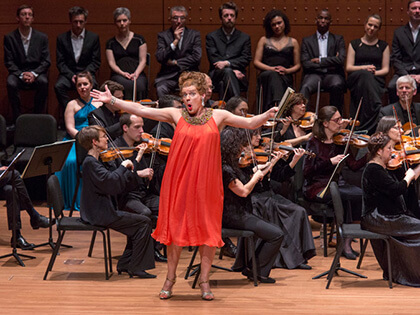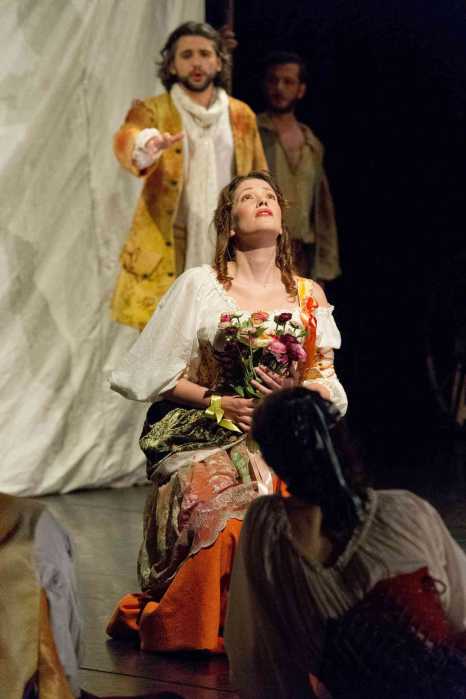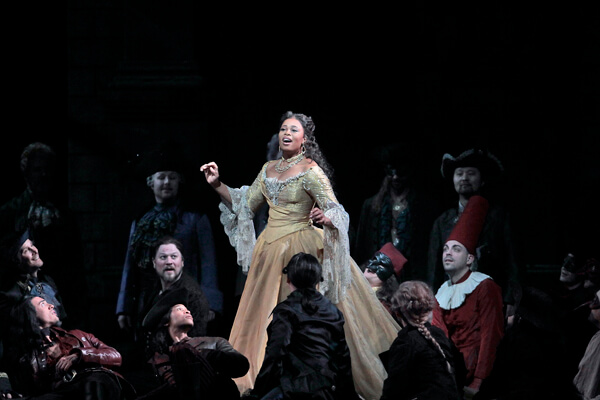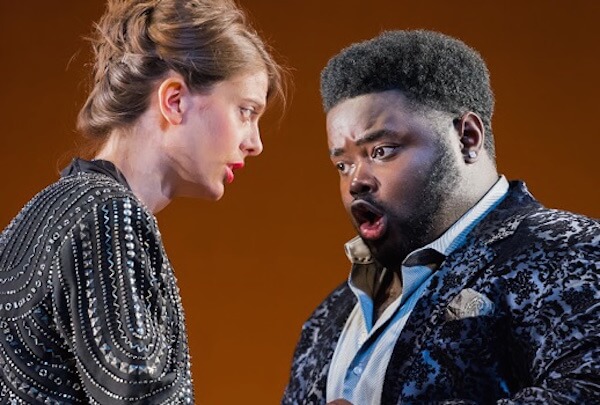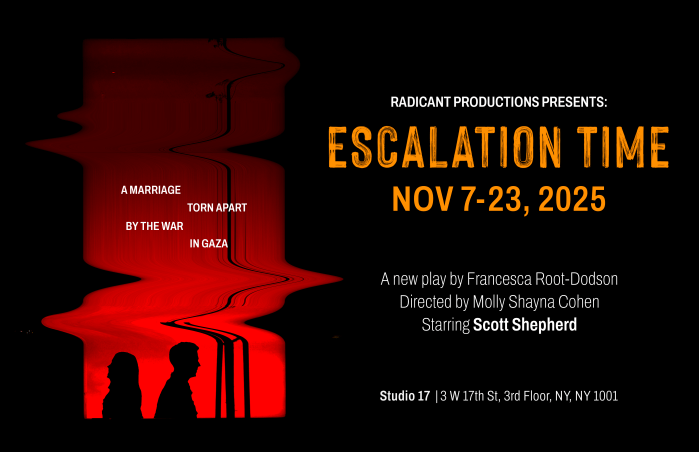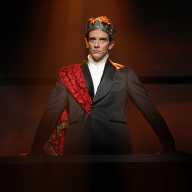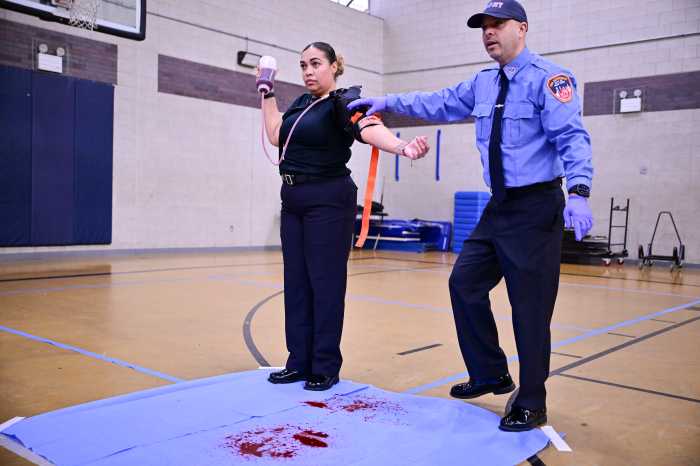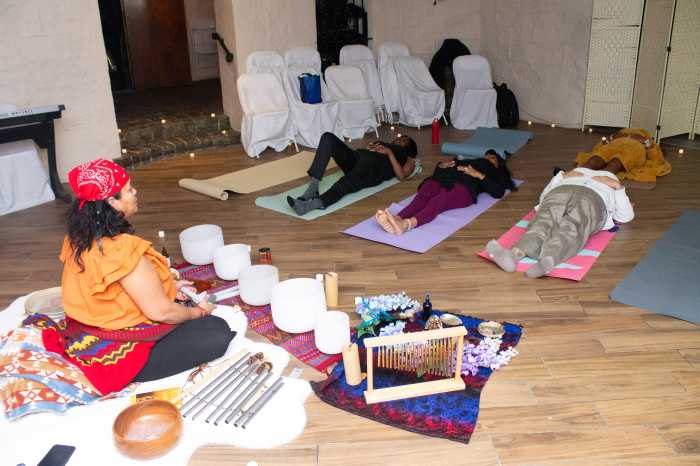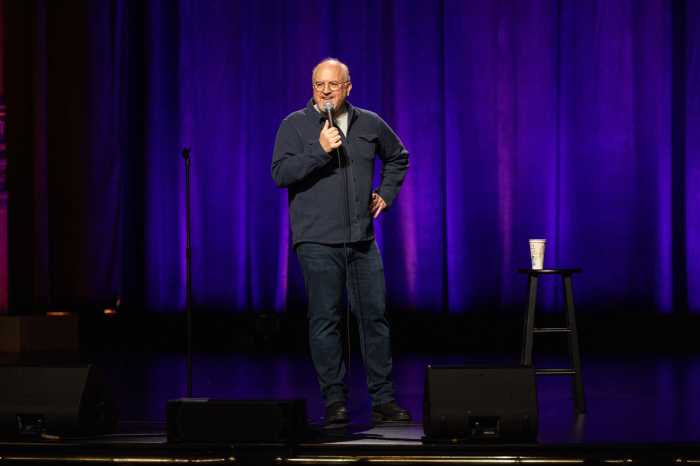Marcel Beekman in the travesti role of Platée in Les ArtsFlorissants’ recent production at Alice Tully Hall. | RICHARD TERMINE
BY ELI JACOBSON | Operatic heroines are always throwing themselves after unattainable men with tragic — or at least ridiculous — results. Donizetti’s elderly Elizabeth I and Rameau’s frog princess Platée play love’s game for high stakes but end up alone, rejected, and swearing revenge.
The English queen jealously covets Roberto Devereux, earl of Essex, but knows his heart belongs to a younger woman. Though the tenor has the title role in “Roberto Devereux,” it is the soprano playing Elisabetta who runs away with the show — and so it was at Opera Orchestra’s concert performance at Carnegie Hall on June 5.
Mariella Devia, never a glamorous or charismatic performer, is 66 years old and never had the extensive and agile dramatic coloratura soprano Elisabetta ideally requires. But Devia is all about the music — no one in opera today better understands the architecture of a bel canto phrase. The core of her voice is miraculously steady, secure, and perfectly under her control. She can sculpt legato lines and fearlessly launch ornaments and trills with complete assurance.
Aging queen, big-boned water nymph look for love in all the wrong places
The fearsome chest register of a Leyla Gencer in the low declamatory sections was never Devia’s to command, and she now eschews the interpolated climactic high D’s and E’s that Beverly Sills gloried in during her heyday (though Devia concluded her final cabaletta “Quel sangue versato” with a strong sustained high D). But neither Sills nor Gencer sang so well in their 60s. Devia is the mistress of the “l’accento” — the instinctive ability to find the right emphasis, the rhythmic and verbal trigger to launch a musical phrase. This compensates for a lack of vocal thrust and weight.
Devia’s mastery highlighted the cluelessness of the performers surrounding her. Tenor Stephen Costello was a bewildering cipher as the titular doomed boy toy. His tone is monochromatically pretty in the middle range but turns tight and bleaty above the passaggio. The climactic C in his prison aria was small and juiceless. Costello phrases mechanically with a blank hangdog expression, dead eyes, and a round-shouldered posture. He connects with no one onstage and only minimally with his character.
Costello, however, at least is experienced in his role, which lyric baritone David Pershall as Nottingham and gifted mezzo Geraldine Chauvet as his wife Sara clearly were not. The nice-looking, pleasant-sounding Pershall was working phrase by phrase with no connection to the text, while Chauvet also had good notes but no sense of the longer line and was buried in her score. Their duets sounded like voice students sight-reading in music class.
No one was helped by Eve Queler’s listless motoric beat; except for Devia, no one onstage displayed a proper sense of rhythmic structure and shaping. Given the last minute, thrown-together nature of the whole enterprise — it was announced just over a month ago — I suspect that rehearsal time was minimal. But we are forever grateful to Queler for bringing so many neglected operas and great singers like Devia before us year after year. Long may she reign.
The heroine of Rameau’s 1745 comédie-lyrique “Platée” is the victim of a cruel practical joke aimed at punishing Jupiter’s wife Juno for her jealousy. Deluded as to the extent of her personal charms, the hideous sea nymph is tricked into believing that the god Jupiter is in love with her.
New York City Opera performed Rameau’s innovative comic masterpiece in 2000, importing Mark Morris’ cheekily delightful production with French tenor Jean-Paul Fouchécourt triumphant in the travesti role of Platée. However, that production made huge musical cuts in the prologue and first act and lacked the virtuoso baroque ensemble this sophisticated opera needs.
It is extremely fortunate that Les Arts Florissants, after staged performances in Vienna and Paris, performed the work complete in concert at Alice Tully Hall on April 2. Even without its founder-musical director William Christie on the podium — he was convalescing from heart surgery but made a spoken introduction to the show — New York audiences finally heard the full genius of Rameau’s witty orchestral writing. Tenor-turned-conductor Paul Agnew (a famous Platée of recent vintage) ably stepped in, eliciting incisive dramatic accents from an ensemble already rehearsed by Christie. Rameau’s orchestra is full of onomatopoeic sound painting effects ranging from the braying of a donkey to celestial choirs that comment on and often mock the onstage action. Agnew and the LAF ensemble landed all the musical jokes.
As Platée, Marcel Beekman was decked out in fashion victim drag — orange halter evening dress and open-toed pumps — designed for the Robert Carsen production. His singing was uninhibited and comically inflected but blunt and unsubtle — more a buffo character tenor than a refined haut-contre, a unique high French baroque tenor with a heady mixed high register.
Typecast as La Folie, Simone Kermes performed in her own inimitable style — a mix of Nina Hagen, Lady Gaga, and Diamanda Galás — while singing like Emma Kirkby on crack. Sporting a leg-baring brocade mini-dress with panniers, Kermes played to the crowd, voguing during roulades and pumping her arms to encourage applause. Her singing was straight-toned with fleeting inaccuracies and anachronistic interpolated altissimo notes that sounded like wolf whistles. Though Kermes’ look and attitude have pretensions to hipness, musically this was anything but HIP (historically informed practice). Like Beekman’s vocal mugging, this approach could be defended as suitable for the character if not Rameau’s refined style.
Matinee idol handsome Edwin Crossley-Mercer as Jupiter impressed me with his sonorous operatic bass-baritone. Veteran LAF tenor Cyril Auvity and baritone Marc Mauillon were a sniggering pair of malicious conspirators, while Emmanuelle de Negri sang brightly as L’Amour and Clarine.
Only Massenet’s Cendrillon, through extensive supernatural intervention, manages to land her prince. “Cendrillon” (1899) has an off-center fractured fairy tale quality to it. Peter Kazaras, the director of Juilliard’s student production (seen April 27) reset the piece in 1947 in a post-war Paris that mixed gritty realism with surrealist fantasy.
Not quite Cocteau, the modest but effective production evoked the whimsical cinematic universe of Jacques Demy’s musical fantasies and Jean-Pierre Jeunet’s “Amélie.” Cinderella’s family lived over the café bistro where she buses tables and washes floors while her father Pandolfe tends bar. Fittingly, her magical fairy godmother was the proprietress of the bijou movie theater across the way and her fairy minions were dressed as usherettes.
The deft conducting of Emmanuel Villaume (who doubled as the Herald, donning a military headdress and delivering a spoken proclamation from the pit) exuded gallic lightness and charm.
Soprano Julia Bullock as the titular heroine has an intriguingly smoky but cool mezzo-tinted middle register allied to a slim silvery upper register. Appealingly natural and unaffected onstage, Bullock drew the listener in with her honesty and directness.
Lacey Jo Benter as her Prince has a dusky dark mezzo of promise but intonation problems, and thick labored vocal emission marred her work. Coloratura Elizabeth Sutphen sparkled as La Fée –– her silvery tone danced precisely over the notes.
As Cinderella’s father and stepmother, Szymon Komasa and Avery Amereau were both announced as indisposed. Komasa’s light baritone and boyish stage presence seemed miscast for his role aside from any indisposition. Amereau’s soignée manner and smooth mezzo-contralto showed no sign of debility.
The polished orchestral playing and choral work further evidenced the love and attention lavished on this charming if somewhat slight piece.

